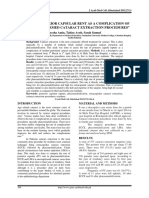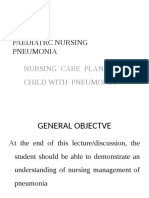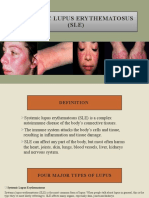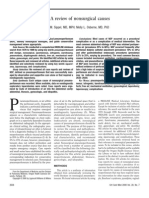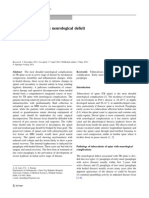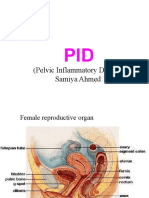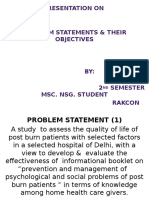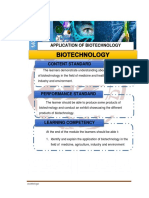Multiple Trauma Management
Multiple Trauma Management
Uploaded by
Setiawan Arif WibowoCopyright:
Available Formats
Multiple Trauma Management
Multiple Trauma Management
Uploaded by
Setiawan Arif WibowoCopyright
Available Formats
Share this document
Did you find this document useful?
Is this content inappropriate?
Copyright:
Available Formats
Multiple Trauma Management
Multiple Trauma Management
Uploaded by
Setiawan Arif WibowoCopyright:
Available Formats
Multiple Trauma
History Time and mechanism of injury Damage to structure or vehicle Location in structure or vehicle Others injured or dead Speed and details of MVC Restraints / protective equipment Past medical history Medications Signs and Symptoms Pain, swelling Deformity, lesions, bleeding Altered mental status or unconscious Hypotension or shock Arrest Differential (Life threatening) Chest Tension pneumothorax Flail chest Pericardial tamponade Open chest wound Hemothorax Intra-abdominal bleeding Pelvis / Femur fracture Spine fracture / Cord injury Head injury (see Head Trauma) Extremity fracture / Dislocation HEENT (Airway obstruction) Hypothermia
Universal Patient Care Protocol
Adult Assessment Procedure focusing on initial ABC and level of responsiveness Spinal Immobilization Protocol Airway Protocol if appropriate
B I P M
Legend MR EMT EMT- I EMT- P
Medical Control
B I P M
Vital Signs including GCS Abnormal Rapid Transport to appropriate destination using Normal Complete Assessment Splint Suspected Fractures Consider Pelvic Binding Control External Hemorrhage Transport to appropriate destination using EMS System Trauma Plan I Continually Reassess
Trauma Protocols
EMS System Trauma Plan Limit Scene Time to 10 minutes Provide Early Notification
I IV Protocol Normal Saline Bolus May repeat for hypotension Splint Suspected Fractures Consider Pelvic Binding Control External Hemorrhage Tension Pneumothorax? Chest Decompression Consider Head Injury Protocol
P M Notify Destination or Contact Medical Control M
Pearls Recommended Exam: Mental Status, Skin, HEENT, Heart, Lung, Abdomen, Extremities, Back, Neuro Items in Red Text are key performance measures used in the EMS Acute Trauma Care Toolkit Transport Destination is chosen based on the EMS System Trauma Plan with EMS pre-arrival notification. Geriatric patients should be evaluated with a high index of suspicion. Often occult injuries are more difficult to recognize and patients can decompensate unexpectedly with little warning. Mechanism is the most reliable indicator of serious injury. In prolonged extrications or serious trauma, consider air transportation for transport times and the ability to give blood. Do not overlook the possibility of associated domestic violence or abuse. Scene times should not be delayed for procedures. These should be performed en route when possible. Rapid transport of the unstable trauma patient is the goal. Bag valve mask is an acceptable method of managing the airway if pulse oximetry can be maintained above 90%
Protocol 57
Any local EMS System changes to this document must follow the NC OEMS Protocol Change Policy and be approved by OEMS
2009
You might also like
- Assessment of The Peripheral Vascular SystemDocument17 pagesAssessment of The Peripheral Vascular SystemgrailbadNo ratings yet
- CataractDocument3 pagesCataractSetiawan Arif WibowoNo ratings yet
- The Global Deterioration Scale (GDS) For Assessment of Primary Degenerative DementiaDocument2 pagesThe Global Deterioration Scale (GDS) For Assessment of Primary Degenerative DementiaI.m. Daniel100% (1)
- Warhol Vanishing AnimalsDocument90 pagesWarhol Vanishing Animalsocr2103No ratings yet
- Reumathoid ArthritisDocument11 pagesReumathoid ArthritisYAny R Setyawati100% (1)
- Doxovent M MedicalDocument38 pagesDoxovent M MedicalkurutalaNo ratings yet
- Class Presentation On Chest InjuryDocument73 pagesClass Presentation On Chest InjuryTabasum Hasan100% (1)
- Amputation AssignmentDocument19 pagesAmputation Assignmentmushimiyimana jacquelineNo ratings yet
- BurnDocument3 pagesBurnhameunjungNo ratings yet
- AppendicitisDocument36 pagesAppendicitisPetro MyronovNo ratings yet
- CCLS IRC ISA CPR Guidelines PPT Rakesh GargDocument67 pagesCCLS IRC ISA CPR Guidelines PPT Rakesh GargPiyush JoshiNo ratings yet
- Airway Obstruction - Types, Causes, and SymptomsDocument6 pagesAirway Obstruction - Types, Causes, and SymptomsGilbertLiem100% (1)
- Monitoring of Patient in ICU: Prepared By: Ms. Anugrah Dayal TutorDocument19 pagesMonitoring of Patient in ICU: Prepared By: Ms. Anugrah Dayal TutorannuNo ratings yet
- Esophageal CancerDocument25 pagesEsophageal CancerK poojithaNo ratings yet
- BurnsDocument44 pagesBurnsJANARTHANAN VNo ratings yet
- Presentation1 Cervical BiopsyDocument14 pagesPresentation1 Cervical BiopsyChanta MaharjanNo ratings yet
- Nursing Care PneumoniaDocument26 pagesNursing Care PneumoniaIsaac Kipkemoi100% (1)
- Ure Thro CeleDocument3 pagesUre Thro CeleKusum RoyNo ratings yet
- Care of Unconscious PatientDocument15 pagesCare of Unconscious PatientAejaz Ahmad100% (1)
- Handout Physical ExaminationDocument2 pagesHandout Physical ExaminationPriyanshi DhankarNo ratings yet
- Definition of AIDS and HIV InfectionDocument7 pagesDefinition of AIDS and HIV InfectionLily SharmaNo ratings yet
- Seminar On Oncological EmergenciesDocument17 pagesSeminar On Oncological EmergenciesawasthiphothocopyNo ratings yet
- 2010 Integrated - Updated Circulation ACLS Prehospital Fibrinolytic Checklist PDFDocument1 page2010 Integrated - Updated Circulation ACLS Prehospital Fibrinolytic Checklist PDFms_lezahNo ratings yet
- Brain AbscessDocument23 pagesBrain Abscessvinnu kalyanNo ratings yet
- Class Presentation ON BPH: Presented By: Ruchika Kaushal M.Sc. Nursing 1 YearDocument31 pagesClass Presentation ON BPH: Presented By: Ruchika Kaushal M.Sc. Nursing 1 YearRuchika KaushalNo ratings yet
- Epilepsy EpilepsyDocument8 pagesEpilepsy EpilepsyJobelle AcenaNo ratings yet
- "Neuro Rehabilitation": Presented byDocument52 pages"Neuro Rehabilitation": Presented byArchana VermaNo ratings yet
- Thoracic Surgery LobectomyDocument21 pagesThoracic Surgery LobectomyJane SharpsNo ratings yet
- Basic Principles of Surgery: DEVELOPING A SURGICAL DIAGNOSIS: Important DecisionsDocument5 pagesBasic Principles of Surgery: DEVELOPING A SURGICAL DIAGNOSIS: Important DecisionsStudent FemNo ratings yet
- Diabetes Guidelines For WebDocument53 pagesDiabetes Guidelines For WebJohn GettyNo ratings yet
- Physical Examination of The 4 Genitourinary TractDocument12 pagesPhysical Examination of The 4 Genitourinary TractrudybisNo ratings yet
- Homan's Test Is An Ankle Examination Procedure That Tests ForDocument3 pagesHoman's Test Is An Ankle Examination Procedure That Tests ForosmosisNo ratings yet
- OsteoporosisDocument12 pagesOsteoporosisapi-340412176No ratings yet
- Necrotizing Pneumonia (Aetiology, Clinical Features and Management)Document8 pagesNecrotizing Pneumonia (Aetiology, Clinical Features and Management)pachomdNo ratings yet
- Case Presentation Laryngitis TB 70 TahunDocument21 pagesCase Presentation Laryngitis TB 70 TahunMegan Shanzu100% (1)
- Constipation 508Document12 pagesConstipation 508Shishir Kumar SinghNo ratings yet
- Sigmoid Volvulus: Rashid Swed S. (Md4) Mwanyingili John A. (Md3)Document46 pagesSigmoid Volvulus: Rashid Swed S. (Md4) Mwanyingili John A. (Md3)Amani Twaha MsemakweliNo ratings yet
- Systemic Lupus ErythematosusDocument15 pagesSystemic Lupus ErythematosusJazel May G. RicoNo ratings yet
- The Wound CareDocument51 pagesThe Wound CareIosefina DudeanuNo ratings yet
- Government of Karnataka: para Medical BoardDocument40 pagesGovernment of Karnataka: para Medical BoardSrikutty DevuNo ratings yet
- Pneumonperitoneum A Review of Nonsurgical Causes PDFDocument7 pagesPneumonperitoneum A Review of Nonsurgical Causes PDFDellysa Eka Nugraha TNo ratings yet
- Acute Stroke ManagementDocument8 pagesAcute Stroke ManagementГурам ЧахвадзеNo ratings yet
- Ectopic PregnancyDocument36 pagesEctopic PregnancyLorenz BreezNo ratings yet
- History Taking and Examination of EarDocument75 pagesHistory Taking and Examination of EarShisam PoudelNo ratings yet
- Neurological ExaminationDocument5 pagesNeurological Examinationshubham rathodNo ratings yet
- Thrombolytic TherapyDocument13 pagesThrombolytic TherapyAnusha AkhilNo ratings yet
- Tuberculosis of SpineDocument11 pagesTuberculosis of SpineSepti RahadianNo ratings yet
- DRUG PRESENTATION On Emergency and CPR DrugsDocument39 pagesDRUG PRESENTATION On Emergency and CPR DrugsShibi BennyNo ratings yet
- PH.D Syllabus: (Part-I:Paper III)Document10 pagesPH.D Syllabus: (Part-I:Paper III)praveena thanavelNo ratings yet
- (Pelvic Inflammatory Disease) Samiya AhmedDocument31 pages(Pelvic Inflammatory Disease) Samiya AhmedSaamiya AhmedNo ratings yet
- Continuous Renal Replacement TherapyDocument38 pagesContinuous Renal Replacement Therapyanju rachel joseNo ratings yet
- A Lumbar PunctureDocument6 pagesA Lumbar PunctureNivinj KennedyNo ratings yet
- BIOPSYDocument8 pagesBIOPSYASHLEY DAWN BUENAFENo ratings yet
- Friday Problem Statement PresentationDocument7 pagesFriday Problem Statement PresentationyashramawatNo ratings yet
- Richmond Agitation Sedation Scale (RASS)Document1 pageRichmond Agitation Sedation Scale (RASS)Arcenciel26No ratings yet
- Intussusception: Prepared By: Aisha H. AlaghaDocument20 pagesIntussusception: Prepared By: Aisha H. AlaghaaiooshaNo ratings yet
- Carpal Tunnel SyndromeDocument7 pagesCarpal Tunnel SyndromeNavjot BrarNo ratings yet
- Ventricular Septal Defect, A Simple Guide To The Condition, Treatment And Related ConditionsFrom EverandVentricular Septal Defect, A Simple Guide To The Condition, Treatment And Related ConditionsNo ratings yet
- Ebstein Anomaly, A Simple Guide To The Condition, Diagnosis, Treatment And Related ConditionsFrom EverandEbstein Anomaly, A Simple Guide To The Condition, Diagnosis, Treatment And Related ConditionsNo ratings yet
- A Simple Guide to Ankle Dislocation, Diagnosis, Treatment and Related ConditionsFrom EverandA Simple Guide to Ankle Dislocation, Diagnosis, Treatment and Related ConditionsNo ratings yet
- Ludwig’s Angina, A Simple Guide To The Condition, Diagnosis, Treatment And Related ConditionsFrom EverandLudwig’s Angina, A Simple Guide To The Condition, Diagnosis, Treatment And Related ConditionsNo ratings yet
- NIH Public Access: The Pathophysiology of Thyroid Eye Disease (TED) : Implications For ImmunotherapyDocument10 pagesNIH Public Access: The Pathophysiology of Thyroid Eye Disease (TED) : Implications For ImmunotherapySetiawan Arif WibowoNo ratings yet
- 31 McMahon - A New Method Keratoconus PDFDocument7 pages31 McMahon - A New Method Keratoconus PDFSetiawan Arif WibowoNo ratings yet
- CanaliculitisDocument12 pagesCanaliculitisSetiawan Arif WibowoNo ratings yet
- Amsler Grid PDFDocument1 pageAmsler Grid PDFSetiawan Arif WibowoNo ratings yet
- Cotton Combed Round Neck 20's (Satuan) Ukuran Putih Hitam Warna LainDocument2 pagesCotton Combed Round Neck 20's (Satuan) Ukuran Putih Hitam Warna LainSetiawan Arif WibowoNo ratings yet
- Publications Safe AbortionDocument110 pagesPublications Safe AbortionSetiawan Arif WibowoNo ratings yet
- Antepartum HemorrhageDocument26 pagesAntepartum HemorrhageSetiawan Arif WibowoNo ratings yet
- Critical Appraisal of The International Subarachnoid Aneurysm Trial (ISAT)Document7 pagesCritical Appraisal of The International Subarachnoid Aneurysm Trial (ISAT)Setiawan Arif WibowoNo ratings yet
- Case Study 5Document5 pagesCase Study 5Dark GamerNo ratings yet
- Great Muslim Philosophers - Ibn Sina and Al-Ghazali (Their Life and Works)Document5 pagesGreat Muslim Philosophers - Ibn Sina and Al-Ghazali (Their Life and Works)Yusuf ImranNo ratings yet
- Substance AbuseDocument8 pagesSubstance Abuseapi-19780865No ratings yet
- Pododermatitis Sept 2010 FINALDocument8 pagesPododermatitis Sept 2010 FINALRezaNo ratings yet
- BSO DSE 01 Block 02Document49 pagesBSO DSE 01 Block 02Amrita BaruahNo ratings yet
- Performance Evaluation of Machine Learning Algorithms in Post-Operative Life Expectancy in The Lung Cancer PatientsDocument11 pagesPerformance Evaluation of Machine Learning Algorithms in Post-Operative Life Expectancy in The Lung Cancer PatientsDanjuma Kwetishe JoroNo ratings yet
- Chapter 1 3Document30 pagesChapter 1 3MIRA CENTINo ratings yet
- Kleinman Culture and DepressionDocument3 pagesKleinman Culture and DepressionАлександра Курленкова100% (1)
- Module 2 - Mental Health and Self-AwarenessDocument21 pagesModule 2 - Mental Health and Self-AwarenessJasmin PotenteNo ratings yet
- Prenatal DevelopmentDocument20 pagesPrenatal DevelopmentVictoria AntonetteNo ratings yet
- Recipes From Easy Sexy RawDocument17 pagesRecipes From Easy Sexy RawThe Recipe Club0% (3)
- 58-Mars in VirgoDocument10 pages58-Mars in VirgoSaptarishisAstrologyNo ratings yet
- Surgery Ww1Document5 pagesSurgery Ww1Gabby ElardoNo ratings yet
- RANZCR Annual Report 2015Document28 pagesRANZCR Annual Report 2015kkkssbbNo ratings yet
- CDC Sampling Procedure For LegionellaDocument6 pagesCDC Sampling Procedure For LegionellaMaynardo GalangNo ratings yet
- S28 - Mr. Kanthala Narender Reddy (Vedic Diagnostics) H.NO.-1-98/13/1, MADHAPUR, Hyderabad-500081, Telanagana ShaikpetDocument9 pagesS28 - Mr. Kanthala Narender Reddy (Vedic Diagnostics) H.NO.-1-98/13/1, MADHAPUR, Hyderabad-500081, Telanagana ShaikpetSiva rajNo ratings yet
- Little Chakra HandbookDocument12 pagesLittle Chakra Handbook37882rmw100% (1)
- Novilyn C. Pataray BSN - Ii Conjunctivitis: St. Paul College of Ilocos SurDocument1 pageNovilyn C. Pataray BSN - Ii Conjunctivitis: St. Paul College of Ilocos SurCharina Aubrey100% (2)
- CPG 5Document29 pagesCPG 5Budio SatyaNo ratings yet
- Calcium MTBDocument1 pageCalcium MTBRisqon Anjahiranda AdiputraNo ratings yet
- REVISED MODULE 4th QUARTER ENVISCIDocument46 pagesREVISED MODULE 4th QUARTER ENVISCIMaui100% (1)
- Aaoms 2010 Sinus Grafting SymposiumDocument63 pagesAaoms 2010 Sinus Grafting SymposiumNAPCO123100% (1)
- Annotated BibliographyDocument2 pagesAnnotated Bibliographyapi-278289906No ratings yet
- Hand SanitizerDocument21 pagesHand SanitizerVitalis MbuyaNo ratings yet
- Circulo Code: OrganotherapyDocument2 pagesCirculo Code: OrganotherapyHomer SimpsonNo ratings yet
- Spinal and Epidural Anesthesia: John H. Turnbull and Pedram AleshiDocument21 pagesSpinal and Epidural Anesthesia: John H. Turnbull and Pedram AleshiAlex Orellana CortezNo ratings yet
- Inquiries and Immersion, Krg846Document33 pagesInquiries and Immersion, Krg846Hannah Louise Gutang PortilloNo ratings yet
- Association Between Repetitive Work and Occupational Cold ExposureDocument3 pagesAssociation Between Repetitive Work and Occupational Cold ExposureAlvaro Ceniceros GuzmanNo ratings yet

